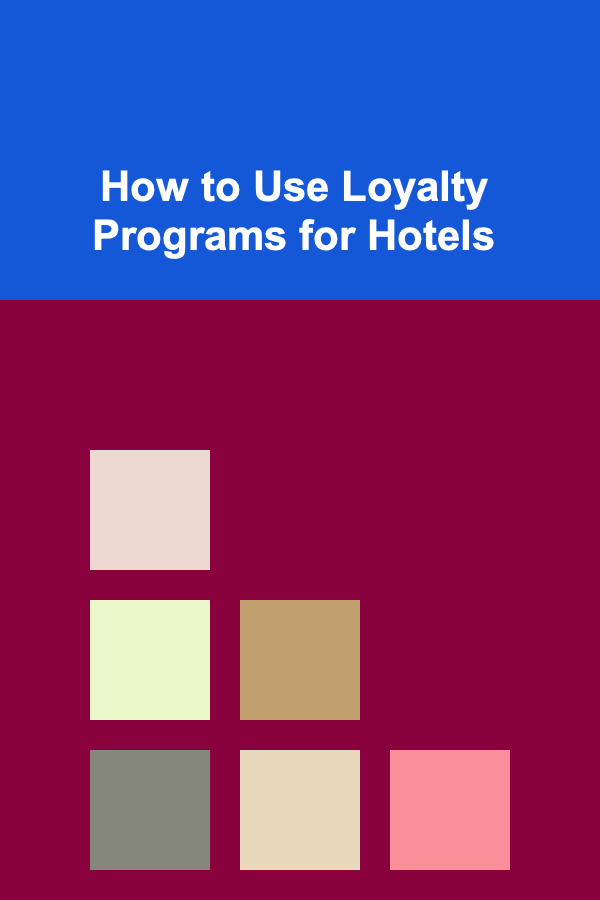
How to Use Loyalty Programs for Hotels
ebook include PDF & Audio bundle (Micro Guide)
$12.99$10.99
Limited Time Offer! Order within the next:

Loyalty programs have become an essential tool for businesses, especially in the hospitality industry. For hotels, they are an effective strategy to retain customers, increase repeat visits, and build a long-term relationship with guests. A well-structured loyalty program can not only enhance customer satisfaction but also generate significant revenue and brand loyalty. In this article, we will explore how hotels can leverage loyalty programs to drive success.
Understanding Loyalty Programs in the Hotel Industry
A loyalty program is a rewards-based system that encourages customers to return to a business by offering incentives for continued patronage. In the hotel industry, loyalty programs typically provide rewards such as points, discounts, or free services in exchange for bookings, purchases, or stays.
Loyalty programs are designed to foster a sense of belonging and appreciation among customers. They provide a tangible benefit to customers for their continued engagement, which in turn strengthens brand loyalty. These programs are not just about offering discounts or freebies; they are about creating long-lasting relationships that encourage repeat business and word-of-mouth promotion.
Key Benefits of Hotel Loyalty Programs
- Customer Retention: Loyalty programs are known to increase customer retention by offering rewards that customers can use during future stays. When customers feel valued, they are more likely to return to the same hotel.
- Higher Customer Lifetime Value: Loyal customers tend to spend more over time. A loyalty program can increase the amount a customer spends on each stay by offering them exclusive access to services or upgrades.
- Increased Bookings: Guests are often motivated to book directly with the hotel when they know they can earn rewards or points. This reduces the reliance on third-party booking sites, which typically take a commission from the hotel.
- Brand Advocacy: Loyal customers are likely to become brand ambassadors, recommending the hotel to others. Word-of-mouth marketing, especially in the travel industry, is a powerful tool for increasing bookings.
- Data Collection and Personalization: Loyalty programs allow hotels to collect valuable customer data, such as preferences and booking behavior. This data can be used to personalize future guest experiences, offering tailored promotions and services that align with their needs.
Types of Loyalty Programs for Hotels
Hotels can implement different types of loyalty programs depending on their goals, target audience, and operational resources. Let's explore the common types of loyalty programs in the hotel industry.
1. Points-Based Programs
The most popular type of loyalty program is the points-based system. Customers earn points for every booking, which can then be redeemed for rewards such as free nights, upgrades, or discounts.
Example: Marriott Bonvoy
Marriott's loyalty program, Bonvoy, is a prime example of a points-based program. Guests earn points for every dollar spent on bookings, dining, and other hotel services. The points can be redeemed for free nights, exclusive experiences, or transferred to airline miles, offering guests flexibility in how they use their rewards.
2. Tier-Based Programs
Tier-based loyalty programs add an additional layer of exclusivity by offering different levels of rewards based on how much the customer spends or stays at the hotel. The more a customer engages with the brand, the higher they progress through tiers, unlocking enhanced benefits and rewards.
Example: Hilton Honors
Hilton Honors is an example of a tier-based loyalty program. Members start at the basic Silver tier and can progress to Gold, Diamond, and eventually top-tier status by staying at Hilton hotels frequently. Each tier offers increasingly valuable benefits, such as room upgrades, lounge access, and late check-out privileges.
3. Membership Programs
Some hotels opt for paid membership programs that give guests exclusive benefits in exchange for an annual fee. These programs are designed for customers who frequently stay at the hotel and are willing to invest upfront for long-term rewards.
Example: The Leading Hotels of the World (LHW) Leaders Club
The LHW Leaders Club membership provides guests with exclusive perks like room upgrades, early check-ins, and personalized concierge services. Members pay an annual fee for these benefits, which are available at LHW's network of luxury hotels worldwide.
4. Cashback Programs
Instead of offering points, some hotels provide cashback or direct discounts as part of their loyalty programs. This is a simpler approach that may appeal to customers who prefer immediate financial rewards.
Example: Radisson Rewards
Radisson Rewards allows guests to earn points that can be redeemed for free stays, but they also offer a cashback option where points can be converted into discounts on future stays.
Strategies for Effectively Using Loyalty Programs in Hotels
While loyalty programs have clear benefits, simply implementing a program is not enough. To maximize the effectiveness of a loyalty program, hotels must develop strategies that encourage customer engagement and long-term participation.
1. Designing an Easy-to-Use Loyalty Program
One of the most important factors in the success of a loyalty program is simplicity. Customers should be able to easily understand how the program works and how they can earn and redeem their rewards. A complicated points system or convoluted tier structure can lead to frustration and disengagement.
- Clear Earning Mechanism: Ensure that customers understand exactly how many points they will earn per booking or dollar spent.
- Simple Redemption Process: The process of redeeming points should be straightforward, whether it's for free nights, discounts, or upgrades. The redemption process should be user-friendly, preferably available through an online platform or app.
2. Offer Relevant and Personalized Rewards
Customers are more likely to engage with a loyalty program if the rewards are meaningful and tailored to their preferences. Hotels can gather data from past stays to personalize rewards, offering guests exactly what they are likely to appreciate most.
- Targeted Promotions: Use data to send personalized offers based on guest preferences, such as discounts for spa services or complimentary breakfast.
- Exclusive Experiences: Offer unique, high-value rewards like exclusive events, VIP access, or personalized travel experiences.
3. Incentivize Direct Bookings
Encourage customers to book directly through the hotel's website or app by offering loyalty program benefits that are exclusive to direct bookings. This reduces reliance on third-party booking platforms, which take commissions from the hotel.
- Exclusive Member Rates: Offer special discounted rates for loyalty members who book directly.
- No Booking Fees: Waive booking fees for direct bookings to incentivize customers to skip third-party platforms.
4. Engage with Customers Post-Stay
Customer engagement should continue even after the guest has checked out. Send follow-up emails thanking them for their stay and offering them an easy way to redeem points or participate in the loyalty program.
- Loyalty Program Reminders: Regularly remind guests of their points balance and upcoming opportunities to redeem their rewards.
- Personalized Thank You Messages: Send personalized messages with discounts or rewards on their next stay to encourage repeat visits.
5. Create Exclusive Member Benefits
Make loyalty members feel special by offering exclusive benefits not available to regular customers. These can include early check-ins, room upgrades, or access to exclusive hotel amenities.
- VIP Treatment: Offer priority reservations, personalized welcome gifts, and other VIP perks to top-tier members.
- Member-Only Events: Host special events such as cocktail hours, cooking classes, or private tours that are only available to loyalty program members.
6. Leverage Mobile Apps and Technology
Many hotels have mobile apps that allow guests to track their loyalty points, book rooms, and redeem rewards all in one place. These apps can make loyalty programs even more convenient and accessible.
- Real-Time Updates: Provide real-time notifications about loyalty points and new promotions directly through the app.
- Mobile Check-In and Checkout: Allow loyalty members to check-in and check out seamlessly using the hotel's app, enhancing the customer experience.
7. Encourage Social Sharing and Referrals
Reward guests for sharing their experiences on social media or referring friends to the hotel. Word-of-mouth referrals are highly valuable in the hospitality industry, and offering rewards for these actions can significantly boost bookings.
- Social Media Campaigns: Offer loyalty points or discounts in exchange for social media posts that tag the hotel or use specific hashtags.
- Referral Programs: Implement a referral system that rewards guests with bonus points or free nights when they refer a friend who books a stay.
Challenges in Implementing Loyalty Programs for Hotels
While loyalty programs can be highly effective, hotels face several challenges when designing and maintaining them.
- High Initial Investment: Establishing a loyalty program requires significant investment in technology, marketing, and staffing. Hotels need to ensure that the return on investment justifies the cost of implementation.
- Program Fatigue: Over time, loyalty programs can become repetitive, and customers may lose interest if the rewards are not compelling or valuable enough. Hotels must continually innovate and evolve their offerings to maintain engagement.
- Balancing Cost and Benefit: Hotels need to strike the right balance between offering attractive rewards and maintaining profitability. If the rewards are too generous, it can erode margins, while too few rewards may result in low participation.
Conclusion
Loyalty programs are a powerful tool for hotels to increase customer retention, drive direct bookings, and build brand loyalty. By designing simple, personalized, and engaging programs, hotels can effectively enhance guest satisfaction and create long-term relationships with their customers. With the right strategies in place, loyalty programs can provide significant competitive advantages in the highly competitive hospitality industry.
Hotels that leverage technology, personalization, and customer data to create seamless, value-driven experiences will be best positioned to thrive in a world where guest loyalty is increasingly a critical factor for success.

How to Choose Paint Colors That Will Transform Your Home
Read More
How to Create a Morning Routine for a Tidy Home
Read More
How to Make the Most of Your Home Budget During Tough Times
Read More
How to Organize Utensils in a Limited Space
Read More
How to Serve Food Buffet-Style at Your Home Party
Read More
How To Plan for Philanthropy in Your FIRE Plan
Read MoreOther Products

How to Choose Paint Colors That Will Transform Your Home
Read More
How to Create a Morning Routine for a Tidy Home
Read More
How to Make the Most of Your Home Budget During Tough Times
Read More
How to Organize Utensils in a Limited Space
Read More
How to Serve Food Buffet-Style at Your Home Party
Read More